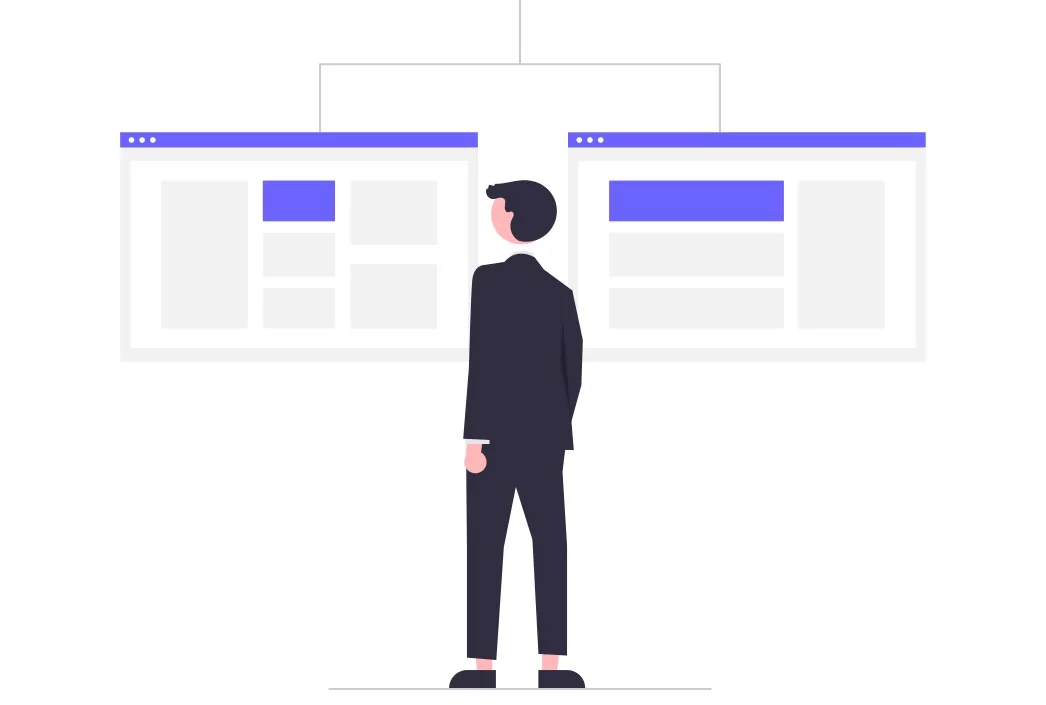
You may have noticed that when you visit a website, you start seeing its ads “following” you. Sometimes, it can be a general type of message; sometimes, you see the exact product you were interested in while on that site. That’s what retargeting is all about.
Repeat marketing, also known as retargeting or retargeting, is simply a way to reach users who have already visited your website.
Using browser cookies, Google knows which users have visited which page so that it can show your ads to specific users. For example, if a user came to your page and saw the men’s shoes category but did not buy anything. You can create a campaign targeting only these users, eliminating the rest.
In this case, you will create very accurate ads that will be more interesting to your user, thus increasing your chance to get that user back on your website. Retargeting gives you a second chance to engage the user, increasing the likelihood of conversion.
Today, we will look into why retargeting is important, what psychological forces are at work, and how to create retargeting audiences in Google Analytics 4 (GA4)
Why Retargeting Matters?
Not all users convert on the first visit; sometimes it takes 2, 3, or even ten visits before a user becomes your customer. Retargeting allows us to recover those who left. This is another chance to convince the user that your product or service is the best choice for them.
At the same time, generic ads often lack the personal touch needed to resonate with individual users. Retargeting campaigns can be tailored based on user behavior.
Since retargeting targets users who’ve already shown interest, the conversion rate is generally higher. This means brands can achieve a better ROI, getting more value for their advertising spend. This does not always work, but 7 out of 10 times, retargeting is a relatively cheap way to get those sales back.
Another popular strategy is to showcase complementary products or higher-value items, encouraging previous customers to make additional purchases.
Even if you don’t increase your sales, repeatedly exposing users to a brand through retargeting ads builds brand familiarity. Over time, this repeated exposure can foster trust, making users more comfortable with making a purchase.
The Psychology Behind Retargeting
The Mere Exposure Effect
The mere exposure effect, also known as the familiarity principle, says that people tend to develop a preference for things merely because they are familiar with them.
Users who see an ad multiple times become more familiar with the brand or product. This increased familiarity can lead to a greater likelihood of them engaging with the ad or purchasing.
The Rule of Seven
This old marketing adage suggests a prospect needs to see or hear an advertisement at least seven times before they take action to buy that product or service.
Retargeting helps brands stay top-of-mind by repeatedly showing ads to potential customers, inching them closer to that crucial seventh exposure. And there is an excellent hack to limit how many times each visitor see your ad. That’s why I usually limit it to 7.
Decision Fatigue
The more decisions user has to make, the worse they get. It’s why shopping for many items can lead to hasty decisions or avoidance of choice altogether. Hasty decisions to buy more it’s okay, well, for business. But usually, when people are tired, they choose not to purchase anything. And that’s not good.
This is where retargeting comes in. If a user was overwhelmed during their initial shopping session and left without purchasing, retargeting can serve as a reminder, nudging them to return and finalize their decision.
The Zeigarnik Effect
People tend to remember uncompleted tasks better than completed ones, a phenomenon known as the Zeigarnik Effect.
If a user added items to their cart but didn’t complete the purchase, they might feel a sense of incompletion. Retargeting ads can remind them of their unfinished business, prompting them to return and complete the purchase.
Trust Building
The process of establishing confidence in a brand or product. Seeing a brand repeatedly can build trust over time. If a user is unsure about a purchase, repeated exposure to the brand can alleviate concerns and establish credibility.
This is why retargeting campaigns are so effective. They tap into users’ psychology. Now that you know how powerful retargeting can be, let’s explore further how I can set you up for success.
Linking GA4 and Google Ads
First things first. We need to link your Google Ads account to Google Analytics. If you’ve done this already, you can just go ahead and skip this part.
Make sure that your email has admin access on both accounts.
Now log into Google Analytics, find Admin in your left menu at the bottom. In the middle column, scroll down to find product links.

There shouldn’t be any accounts unless someone else linked them. If there are, check if the link is correct. Look at the Google Ads account ID and check it with your current Google Ads account. Sometimes, when agencies handle your Google ads Account, they link it for you.
Click on Link accounts and select the first option. This is what you should see:
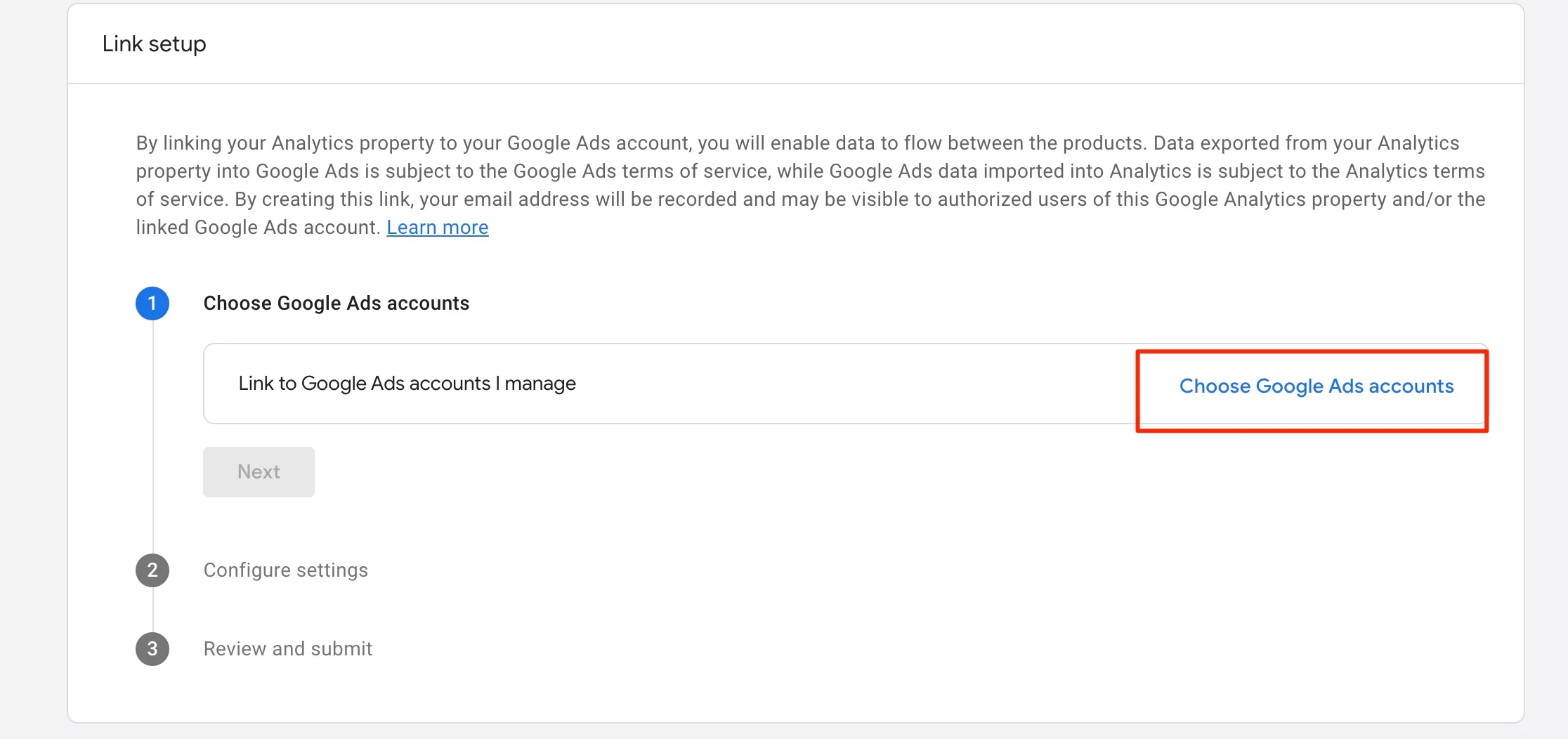
Now, find your account. It can be just one account if you have a lot, use search.
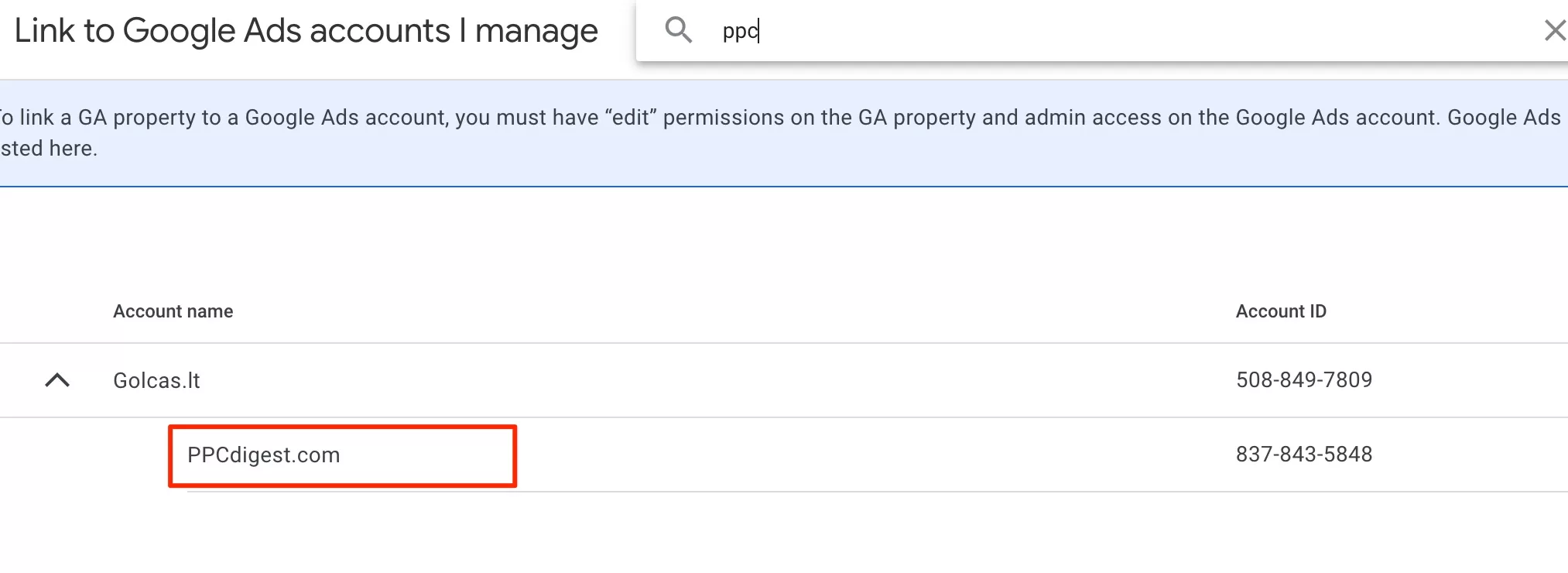
Once you found your account, select the check box and press Confirm—top right button. You should be taken back and see the Next blue button. Click it.

By default, both options are selected, just leave them as it is. Also, make sure auto-tagging is enabled. By default, it is. Click Next and then click Confirm.
Your Google Ads and GA4 accounts are now linked.
Crafting Retargeting Audiences in GA4
Let’s create your first retargeting audience. I must mention that usually two are created automatically: “All users” and. “Purchasers”. Ideally, you would want to create your own.
After linking your accounts, you should be in your Admin area. You can find Audiences in your middle column.
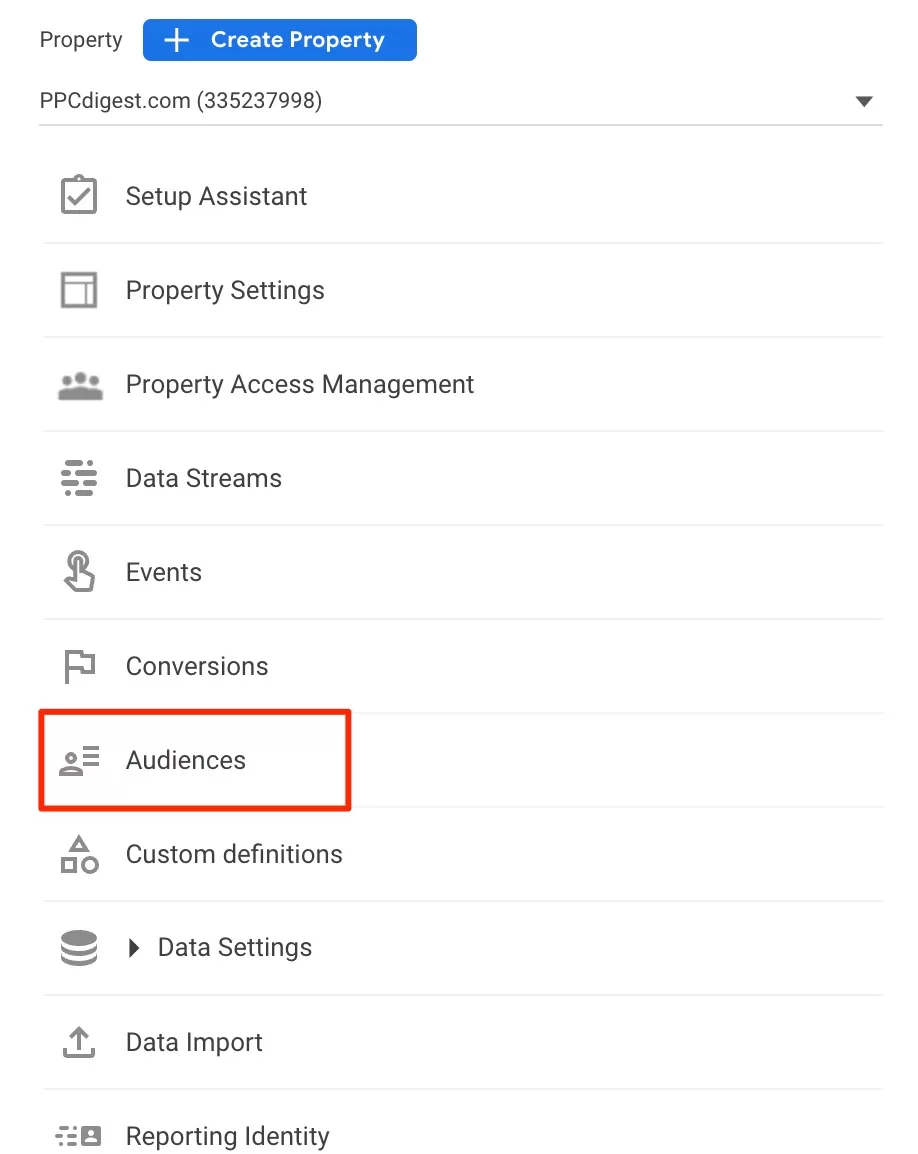
You should see this screen with one or two audiences created. There might be more if someone else created them. This is where you will see all your created audiences. Now click on Create new.

Google will offer you to create prebuilt audiences. Those are fine to use, but I prefer to use my own.

Click to create an audience from scratch. You will be taken to a page that seems overwhelming, but it’s not. Let’s unpack.
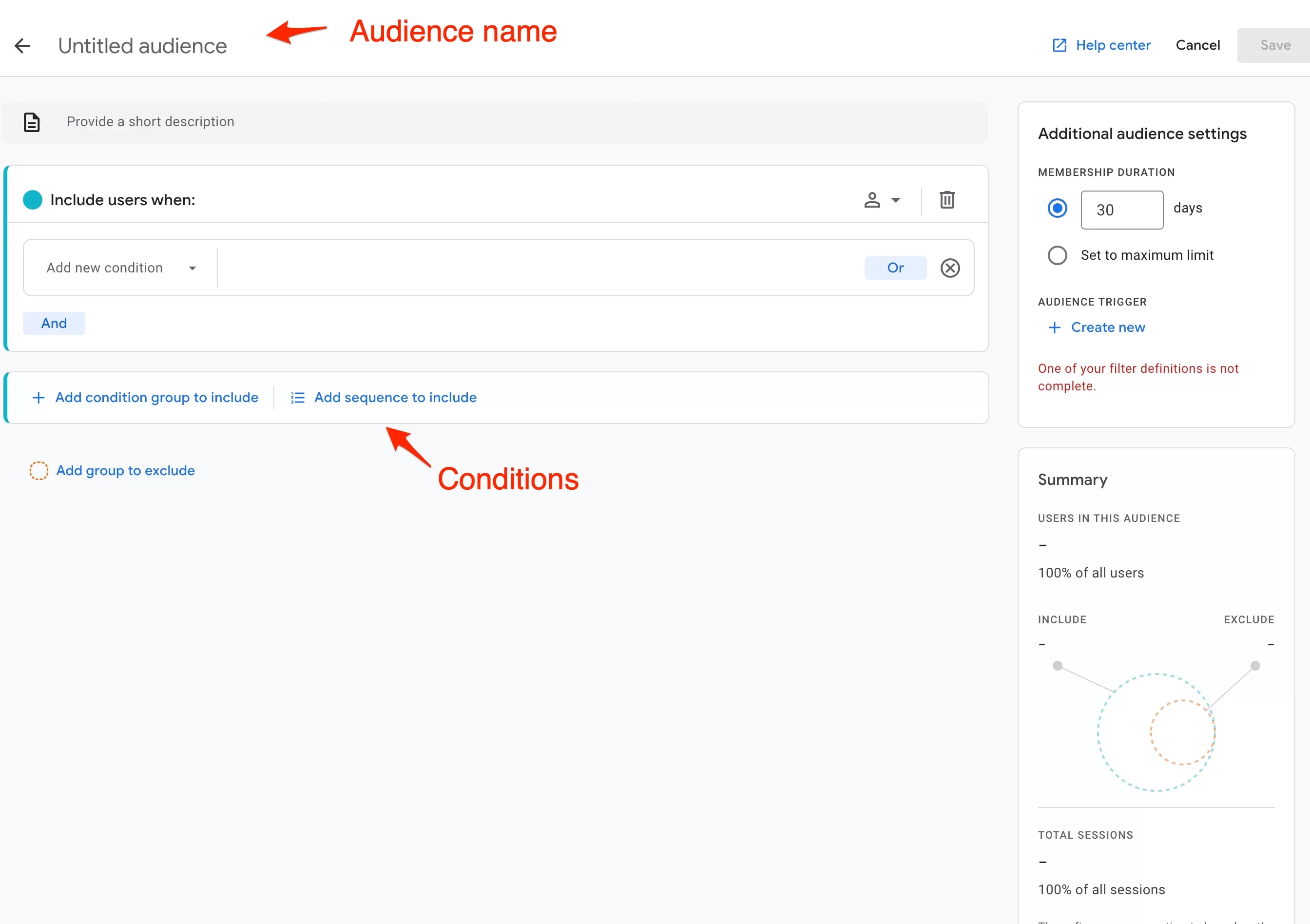
First is the name. I would recommend having some naming convention—for example, [GA4] Product viewers [non-purchasers] [30d].
I specify GA4 at the start because I may have more audiences in my Google Ads account. Some of them would be created through a Google Ads account, and some of them may be custom. Naming it that way helps me identify where I created that audience. But you can skip that, as you might have created all your audiences in GA4.
Next comes the main audience name who I want to target. In this case, all users who viewed a product. And I also add that I exclude people who purchased anything. Usually, you should exclude all purchasers or converters. You don’t want to show ads to people who bought from you. It might be annoying for them.
The last is the audience membership duration. The default is 30 days. What does it mean? Each user can be assigned to an audience for a specific time. After that time, that user is no longer part of the audience and won’t see your ads. You don’t want to keep people in your audience for a long time. You want to optimize that.
The membership duration time depends on the product or service. Usually, it is derived from your data. But if you’re new, use the default.
Otherwise, you can use a simple formula (ish). If the product is expensive, users need more convincing, meaning longer membership duration. For cheaper products, this can be reduced to 7 or 14 days. This means that if the product is cheap or people tend to buy it right away, there is no point in showing ads to them for 30 days. A week might be enough. They will either buy or not, and showing more ads will likely have no effect. You will just be spending money.
The name does not affect anything. This is for you so you know what users are in this audience. So name it as you please.
Let’s get our hands dirty. Click on Add new condition. You should see a list of various dimensions and events. This is where you have to select your condition. Ideally, all your dimensions are in GA4, but sometimes, you might need to add extra events as they are not collected by default.
For the sake of simplicity, lets create a simple audience. I will use my blog as an example. I want to create an audience of users who visit my book page. Since I know the URL, it should be easy.
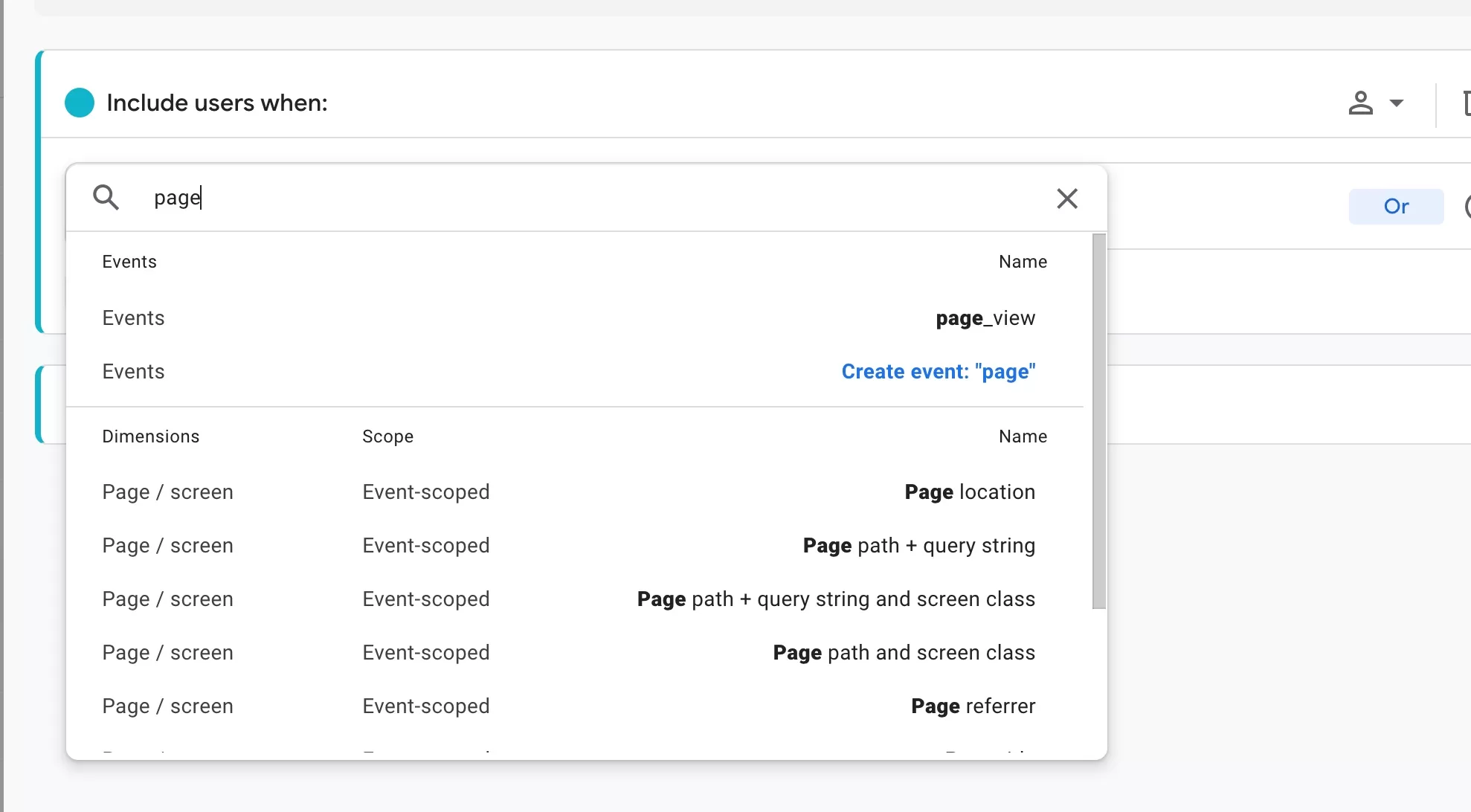
I use search to find the dimension that I need. There are several, but I need the one where I can specify the page path (/google-ads-blueprint/).
Once I select it, I can add a filter. Otherwise, it will match all pages. So I select contains and enter my path.
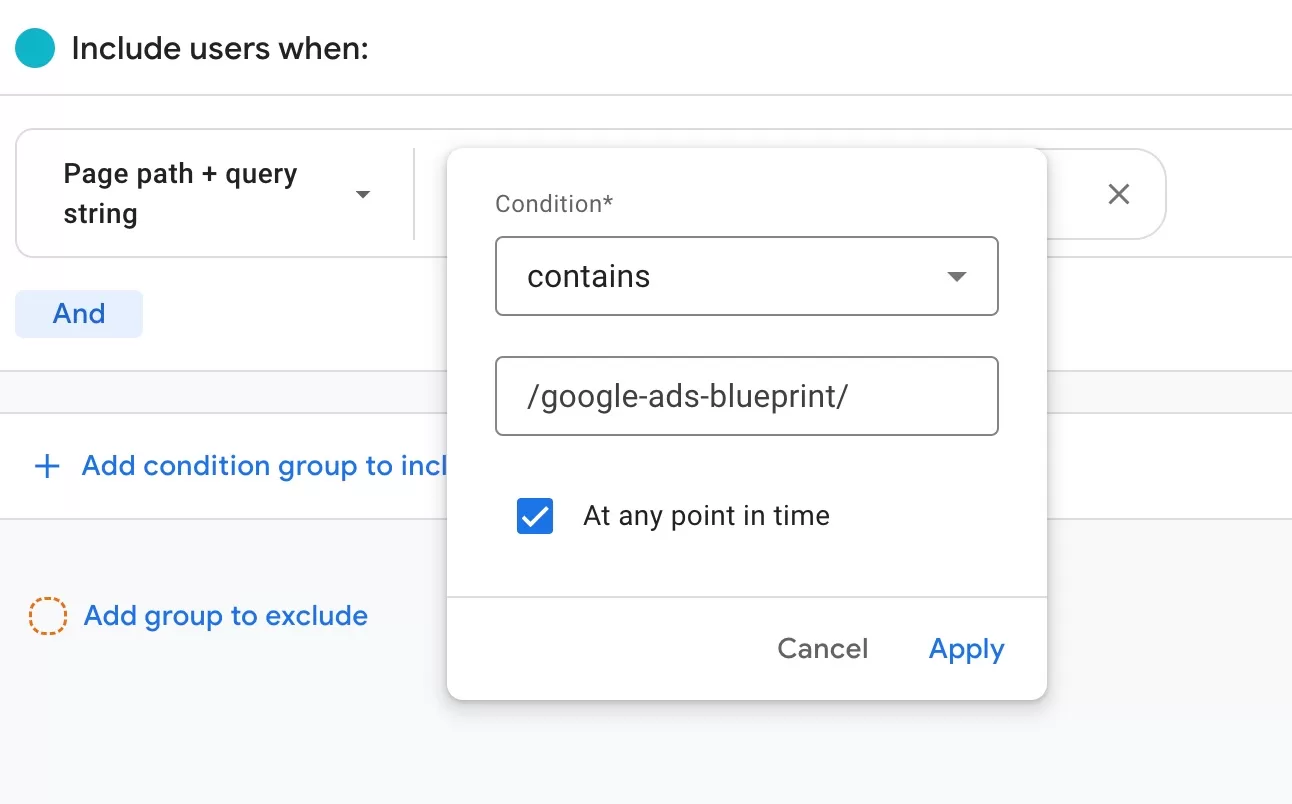
Now, you can click Apply. After that, you can check your right column where it says Summary. It will show you how many users and sessions this audience has. This is a great way to see if you’ve done everything right. Because if you see 0, it means either there are no users matching your filters or you made a mistake.
This is a simple audience based on one condition: a page path. You can create as many audiences as you want, but remember that for retargeting to work, you need at least 100 active users in your audience. For YouTube and Search campaigns, it’s 1000 active users.
For the best performance with display campaigns, you need a couple of thousand users.
Now, let’s look at more advanced techniques.
Advanced audience creation techniques
Combining multiple conditions
Before, we created an audience based on one condition. Now, let’s add a few. In audience creation, there are two options to add a second condition: “or” / “and”.
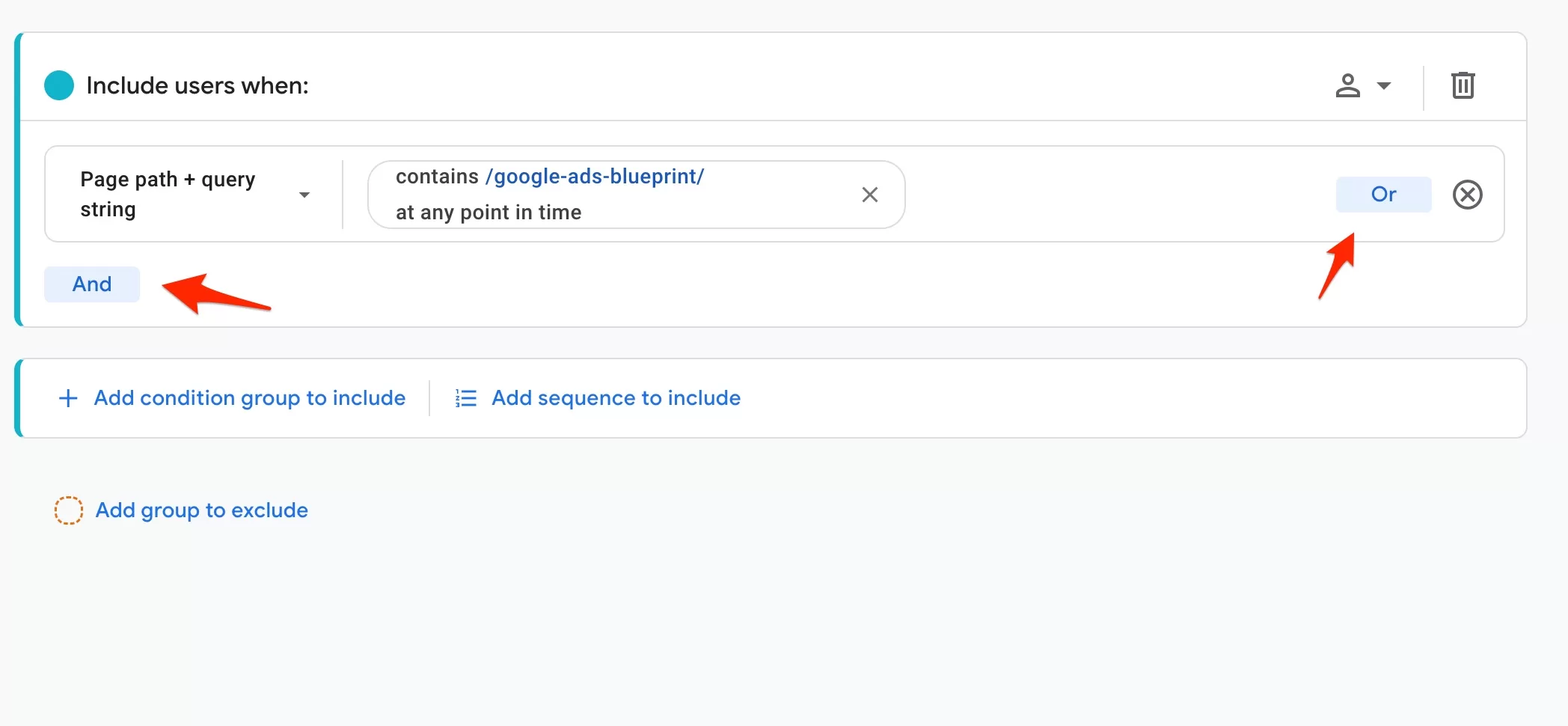
If you use the “or” condition, Google will look at either of those and add users to this audience. Here’s an example: You specify a device, mobile or desktop. Then, this audience will contain users using either of those devices.
“Or” condition is good when you want to add many things to an audience, like people who viewed several of your key pages. Here, I specified that I want users who visited my post about YouTube ads or a post about Facebook ads.
If I use the “and” condition in the example above, then Google will only include users who visited both posts.

So, the “and” condition is more limiting, as both conditions have to be matched. With small-traffic websites, using “and” is irrelevant, as you will get very small audiences. But when there is a lot of traffic, you need several conditions to find particular users you want to target. For example, users who viewed women’s category pages AND visited shopping cart but did not buy. Here we have three conditions, and all of them are “and” conditions:
Page path > contains “women”
and
Page path > contains “add-to-cart”
and
Items purchased > =0
Sequences
This is a much more advanced option and usually needs a lot of traffic. In this case, we are also targeting users’ behavior. We’re not only specifying conditions but also steps in which these conditions happened.

Here’s an example:
I want to target users who visited the home page and then visited my book page.
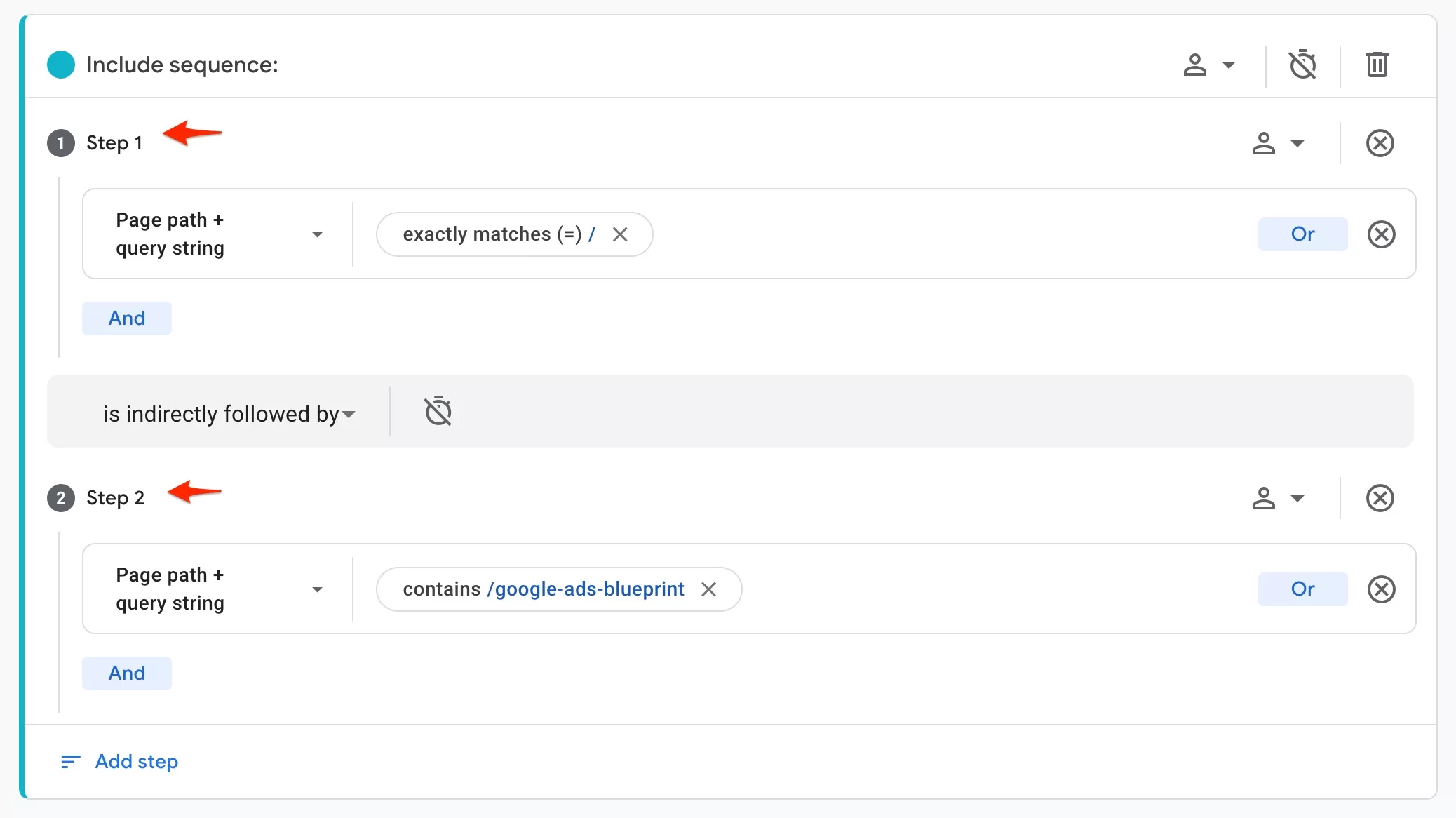
I specify step 1 and add a condition like before, but then I add step 2 and specify a condition there. Users will be added to this audience if they match this sequence. Step 1 has to happen before step two, and so on. This is the difference between “and” condition.
Furthermore, you can specify if these steps are happening directly or indirectly:

Indirectly means that the second step does not need to come immediately after step 1. And directly is the opposite; the second step has to come after the first one. So, in our example, with the “directly followed by” option, users must come to a home page and immediately go to a book page. This is the only page that can be in between those steps.
And if you want to go even deeper, you can specify a time frame for those steps. A small watch icon above. If the step happens beyond your specified time frame, it doesn’t count, and the users are not added to this audience.
For now, I would not recommend using it as it requires more practice with retargeting and a lot of data from your website to draw conclusions.
Exclusions
And last but not least – exclusions. After sequences, this is a walk in the park. Usually, when creating audiences, you include things. But sometimes, you need to exclude a condition from all your audience. A simple example is an audience of non-purchasers. It’s all your users minus the ones that converted.
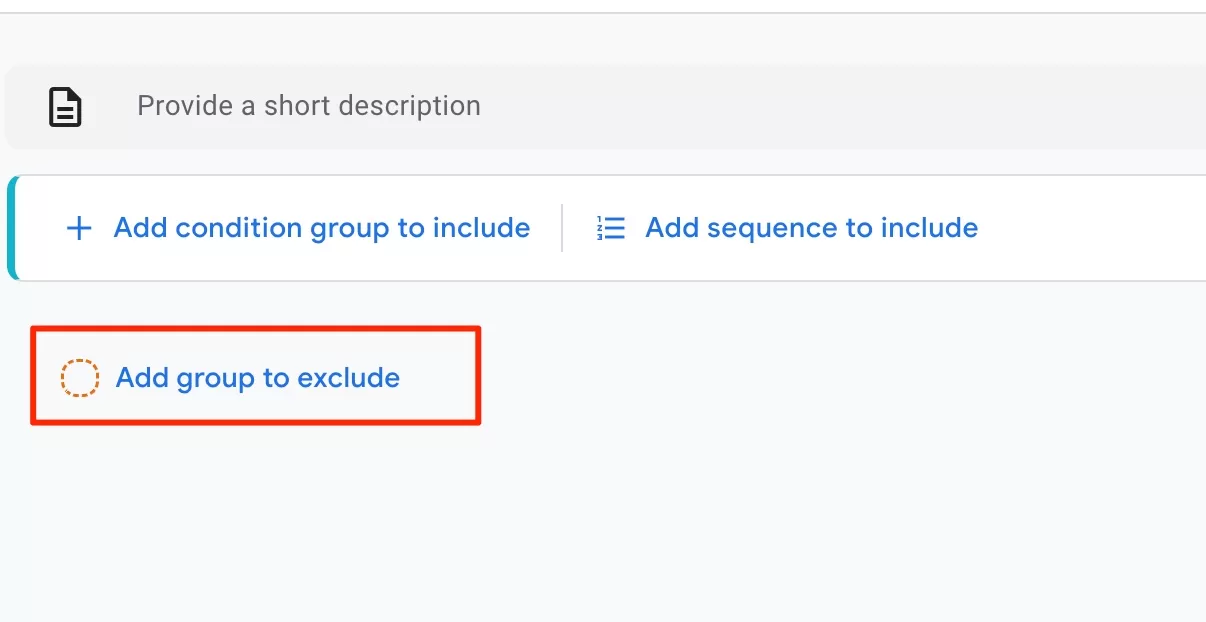
In the example below, I just excluded users who visited my book page.
I can use this audience to target people unfamiliar with my book since they have yet to visit that page.
Best Practices for Retargeting Audiences
Ensuring audience size is optimal for effective retargeting
I mentioned this already, but it’s worth mentioning it again. Each campaign type (search, YouTube, display) has a minimum requirement for users in the audience. For display campaigns, it’s 100. I recommend a lot more, at least a thousand. But if your site is small and your product is niche, go for it. There is no golden rule for the size (except the minimum requirement); you just have to launch your retargeting campaign and see how it goes.
If you have a large website, you must create several audiences based on various behavior factors. Don’t just create an “all users” audience and show them the same banners. This is just a waste of money. Think about who you want to target again (retarget) and what you want to show them (since they already have been on our site).
Refreshing and updating audience lists periodically
The audience updates automatically based on your specified conditions. After some time (usually 30 days), some users are removed from it, and new ones are added.
But what sometimes changes is the conditions. URLs might change after the redesign, events might stop functioning after an update, and user behavior might change. Ensure you check occasionally if the conditions you specified for the audience are still valid.
Avoiding audience overlap and redundancy
This is an important one. Make sure to create an audience that doesn’t overlap. Don’t create two audiences with similar conditions. Otherwise, this will make it much more work to develop ad creatives and choose what to offer. Ideally, each audience is a segment of different people.
Suppose you have an audience of men who added items to the cart and then a different audience of women who added items to the cart. Don’t create an audience of all users who added items to the cart. If you do, you have to exclude from that audience men and women so that those audiences are distinct.
Common audiences to create
You can create hundreds of audiences based on whatever you think might help convince people to come back and buy (or whatever your goal is). At the start, it might feel overwhelming. Start with essential audiences and see how they perform.
Create an audience of people who visited a cart but did not buy. Create ads and run your campaign. Check performance, make changes, and iterate.
Retargeting can be a great way to increase sales, but that does not mean it always works. You will have to go through several campaigns to find what is working for your business.
Here’s a list of more common audiences.
Converters (purchasers)
This is one of the first audiences I created. These are the people who bought something, signed up, or did anything that I constitute as a conversion.
Two reasons why:
- I can target those people to offer additional services or products;
- I can exclude them from other campaigns and not bother them again since they are already my customers.
Category visitors
This is what we talked about above during the creation process. I identify categories on the website to target those users. It can be clothing categories, service categories, and so on.
I then can add specific creatives for each audience.
Cart visitors
If someone visits your cart, that most likely means they have added a product to the cart, which is a strong signal. You don’t just randomly add products to your cart, right? I can retarget those people if they have not completed a purchase.
Key page visitors
It depends on your website and what page you think is essential for you. For a company that does not sell anything online, it might be the “Contact Us” or “About Us” page or even “Where to find us.” This is an indication that people are expressing more interest in your company.
It also might be a Sales page or a Brochure page. Your goal is to identify users that are more engaged through your content. You will get many users who will never buy anything from you. And you want to retarget those who have a higher chance of converting.
Email subscribers
Even though you can send emails with offers to people who subscribed, I found that by using retargeting, you can also make sales and increase engagement.
Used search on your website
People who use search on your website are usually much more engaged and have a higher conversion rate. You should utilize them in your retargeting campaigns as well.
Blog visitors
If you have a blog, create an audience that reads your blog and come up with an offer for that audience. They also have a higher chance of converting.
Conclusion
I’ve been doing this for 14 years or something. And no matter what client I had, retargeting campaigns were one of the top things I created or optimized. This is easy money. Don’t undervalue the power of retargeting.
The beauty is that you don’t even have to create many of them. A few at the start is enough to see if this campaign type can work for you. My only advice is to look at your business and your own data. Sure, there are some best practices and audiences that usually work. But you know your business better, and you have the data. Check data first, see what sections of your website are getting traffic or engagement, and consider how to use that for retargeting.
Also, remember the creatives. One of the critical benefits of retargeting is the ability to show specific ads to that audience. The engagement is a lot higher. This is the warm audience we’re talking about.
And think about the landing page. It’s important not to use your home page (with few exceptions). Since you know the audience and your creatives are tailored to that audience, where they land after the click is also important. Please be careful when selecting your landing pages.
I share weekly tips on how to create, manage, and scale Google Ads campaigns. Subscribe to my free newsletter.
I’m also down with connecting on LinkedIn.
Or follow me on X, for some quick updates and fast insights.

